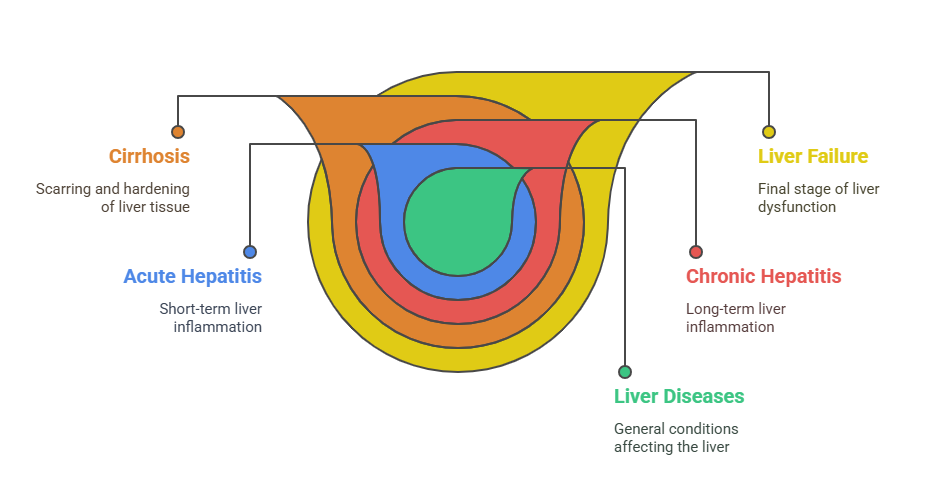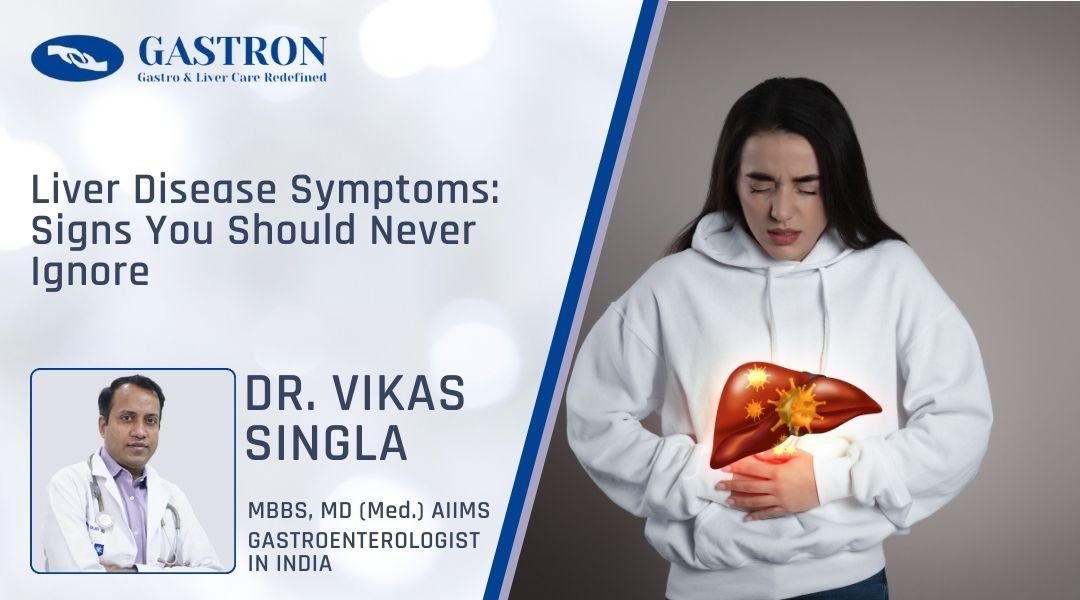Many a times, patients come to us feeling that their liver is not functioning properly and may be damaged due to liver disease.
First, we need to understand what symptoms can occur when there is liver disease. Before that, it is important to know the role of the liver in our body.
Function of Liver
The liver is located on the right side of our body. One of the main functions of the liver is to produce bile.
Bile is stored in the gallbladder and then secreted into our small intestine through the bile duct.
When we eat food, it reaches our small intestine, where it mixes with the bile produced by the liver. Bile helps in digesting that food.
The second function of the liver is to remove toxins from our body.
A waste product called ammonia is produced in the body, and its removal is also carried out by the liver.
The liver converts ammonia into urea, and this urea is then eliminated from the body through the kidneys. This shows the link between liver disease and kidney disease.
The third important function of the liver is to produce certain essential proteins.
The liver makes proteins that help in blood clotting.
When we get injured and bleeding occurs, it is important to stop the flow of blood, and for this, certain proteins are needed, which are produced inside the liver.
This is why patients with liver disease tend to have thinner blood and an increased risk of bleeding.
The liver also produces another important protein called albumin. The role of albumin is to maintain the volume of blood in our body.
If the level of albumin decreases, water starts leaking out from the blood vessels and accumulates in areas like the abdomen or legs a condition often seen in liver disease with ascites.
Disease Affecting Liver

Now let us understand the different liver disease types that can affect the liver.
Normally, we can observe that due to certain conditions, the liver becomes swollen and enlarged. This condition is called hepatitis.
If the duration of hepatitis is less, it is known as acute hepatitis, which happens due to Hepatitis A and Hepatitis C virus.
If the duration of the hepatitis is longer, then it is known as chronic hepatitis, caused due to hepatitis B and hepatitis C virus, and is a major liver disease risk factor.
If this condition persists long, it can harden and shrink the liver, and this condition is known as cirrhosis.
Sometime, blockage develops in the bile duct, which may be caused due to stone or tumour formation.
This condition restricts the passage of bile and the pigment in bile, which is known as bilirubin, releases in the bloodstream, leading to liver disease jaundice.
When hepatitis persists for a long time, it is referred to as chronic hepatitis. It often occurs in patients with diabetes as well.
Over time, the liver tissue develops scarring, a condition known as cirrhosis. Cirrhosis can further progress to liver disease last stage, liver failure or even develop into a tumor.
As a result, the liver loses its ability to function properly, and substances meant to be processed by the liver can start accumulating in the blood.
Symptoms of Liver Disease
Let us now understand what symptoms can appear in patients with liver disease symptoms female or male. One major symptom is a constant feeling of tiredness or fatigue. These patients get exhausted quickly, especially after any physical activity. This is a common liver disease symptom.
The main cause behind this fatigue is chronic hepatitis. Whether it is chronic hepatitis B, C, or autoimmune hepatitis, the outcome is similar. In autoimmune hepatitis, the body’s immune system attacks the liver itself, producing antibodies against the liver and resulting in liver disease pain area and liver dysfunction.
In autoimmune hepatitis, the body’s immune system starts attacking the liver itself. It produces antibodies against the liver, leading to its damage and resulting in the liver’s inability to function properly.
Apart from this, chronic hepatitis can also occur due to the accumulation of copper or iron in the liver.
A major symptom of chronic hepatitis is persistent fatigue or tiredness. When we conduct blood tests, two liver enzymes – commonly referred to as SGOT and SGPT – are measured.
Their levels are usually elevated in cases of chronic hepatitis. Normally, these enzyme levels are around 40, but in such conditions, they can rise to 200.
The next symptom of liver disease is the development of jaundice. In liver patients, the skin and eyes start turning yellow, and their urine also becomes dark yellow.
This condition is known as jaundice. The main reason for jaundice is swelling of the liver, and this condition is known as acute hepatitis. Acute hepatitis is caused due to hepatitis A and hepatitis E virus, which sources from contaminated water and foods.
The next cause of swollen liver is due to the excess consumption of alcohol, which can cause jaundice. If there is a blockage in the bile duct, caused due to stone or tumour, this can also lead to swollen liver, causing jaundice.
When we test patients for jaundice, we find elevated levels of bilirubin in the blood.
The next symptom of jaundice is reduced appetite and vomiting after eating, including fever.
In this condition, patients may have acute hepatitis. When we test the patients, the levels of SGPT and SGOT are in thousands.
The next symptom of liver disease is itching. Some patients may experience itching all over their body, and this is more at night time.
There is a condition known as primary biliary cirrhosis, wherein, bile salts level increase, which causes body itching.
When we test these patients for liver disease, we observe elevated levels of serum alkaline phosphatase in the blood.
The other symptom of liver disease is continuous pain in the upper abdomen region, which is caused due to fatty liver. Some patients do not consume alcohol but still they are diagnosed with fatty liver in their ultrasound report.
This condition is known as non-alcoholic fatty liver. Some patients who have developed tumours in the liver, especially those with liver cirrhosis.
This also caused pain in the upper abdomen region. Even in acute hepatitis condition and other conditions, where the liver swells due to alcohol, they can also cause upper abdomen pain.
The other symptoms of liver disease are swelling in the stomach and legs.
As we discussed, in liver patients, the amount of albumin in the blood decreases. The albumin in the blood vessels holds the blood.
When albumin decreases in blood, water starts to release from the blood vessels and settle either in the legs or the stomach region.
This condition is known as ascites or pedal edema. Cirrhosis is the main reason behind this condition, where the level of albumin decreases, causing fluid deposit.
Another symptom of liver disease is blood vomiting. In cirrhosis patients, the liver gets hardened, and the blood that is supposed to enter the liver, bypasses it and enters the food pipe, causing blood vomiting.
Some liver patients may have bleeding inside the skin. Liver produces some proteins, which refer to a coagulation factor that helps in blood clotting.
These proteins are less produced in patients with liver conditions, and even if they get a small cut in their skin, it leads to bleeding.
When we test these patients, their prothrombin time and INR levels are diagnosed high, which indicate that their blood is thin.
The next symptom of liver disease is loss of muscle mass. In liver cirrhosis patients, their muscle mass starts to disintegrate and starts releasing protein.

